Do you have green fingers? I don't. I know next to nothing about growing plants. Still, you do not need extensive knowledge of horticulture to know that if you want to enjoy a rich harvest, you need time, skills, favorable conditions, and properly selected tools.
Inbound marketing is the same.
Many marketers expect immediate results from their inbound marketing strategies. Failing to notice the outcomes quickly, they give up and shift back to the old methods, replacing germinating plants with artificial ones. Meanwhile, the problem isn’t the ineffectiveness of inbound but rather the lack of understanding of its principles. After all, every experienced gardener will admit that the key to success is patience and sticking to a set cultivation plan.
To rebuild marketers’ faith in B2B inbound marketing, I will show the greatest advantages of the inbound methodology. My insights are based on more than eight years of 6Minded's experience in implementing inbound strategies and tools among B2B companies worldwide. You will also see how inbound strengths have helped our clients and learn how to leverage them to reap the rewards of inbound marketing strategies for yourself.
What is inbound marketing?
Before we go any further, let’s recap the inbound marketing definition. By definition, inbound marketing is about building and nurturing long-term and meaningful relationships with customers, primarily through personalized content. In contrast to outbound marketing, focusing primarily on amassing a large number of leads, inbound marketing methodology reaches a smaller but selected group of recipients, offering solutions to their problems or meeting specific business needs.
The fundamentals of inbound marketing methodology
To successfully implement an inbound marketing strategy, you must know its key elements and how they intertwine. Just think of preparing a mixture of soil for potted plants. Here are the ingredients you’ll need:
- Definition of objectives: Increased traffic on the site? Getting new leads? Regardless of what results you want to achieve, the basis is to determine them and direct actions toward their implementation. With a clear goal, you can more easily measure your inbound campaign outcomes and draw productive conclusions for the future.
- Understanding customers: To present your products and services attractively, you must know whom you are talking to. That’s why when following an inbound marketing strategy, it is so important to create a persona (or a few) of the ideal customer. The persona will specify the needs, problems, and preferences of your buyer. Only with this information in hand can you build an effective inbound marketing message.
- Tracking the buyer's journey: You should always be mindful of the buyer's journey, from the phase of seeking the right solution to making the purchase. This knowledge allows you to adjust content to your leads at every step of their purchasing journey and—as a result—fix a leaky sales funnel.
- Content creation: Knowing the target audience and how it interacts with your offer, you’ll find it easier to create valuable marketing content. In the problem recognition phase, for example, articles on the following topic will be helpful: “How do I increase my sales in my company?” Customers considering available solutions will appreciate a case study answering the question: “Why will this method increase sales in my company?”
- Analysis of results: Systematically check the effects of your inbound marketing activities and set benchmarks to optimize campaigns and content constantly. Knowing what works and what doesn’t, you’ll understand how to appeal to the hearts of customers and keep them for longer.
Is following an inbound strategy worth it?
In some countries, inbound marketing is a relatively new concept, and while many marketers already apply its principles, they do it intuitively rather than purposefully. In countries like USA or UK, B2B inbound marketing has a more established position, and it has already become one of the leading methodologies:
- 60% of companies in Europe use inbound marketing strategies. In the United States, the numbers are similar.
- 70% of marketers actively invest in content marketing as part of their overall strategy.
- The main source of website traffic is direct traffic (22%), which shows the significance of brand awareness that inbound marketing helps nurture.
Key benefits of inbound marketing strategy
Systematic inbound activities have a positive impact on the marketing and financial success of any business. This is confirmed by the numbers!
- A properly implemented inbound marketing strategy is 10 times more effective in terms of conversion than an outbound marketing strategy.
- Inbound marketing costs 62% less per lead than traditional outbound marketing.
- 56% of marketers who use a blog say it is effective, and 10% say it generates the greatest return on investment.
The results are undeniable and directly tied to the benefits of inbound marketing. Here are the most important ones to consider when thinking about implementing B2B inbound strategy.
Inbound marketing strategy allows qualified leads to blossom
There are many ways to attract new customers, and the beauty of inbound marketing is that it is based on fairly simple and repetitive processes.
How about an example?
Take a company that offers network security systems for small business owners. The first thing it has to do is to identify the problems of potential customers and build personas accordingly. They should include customer frustrations and how to resolve them effectively. Regarding the obstacles that might prevent the audience from buying our example company's solutions, low threat awareness and fear of investment costs are topping the list.
In the context of these challenges, our company can create a social media post with a convincing CTA redirecting the audience to a landing page. On the page, visitors can download a short guide to the biggest digital threats among SMEs. To get the asset, they’ll be asked to fill out a short form (thanks to which our company will gather data for later contact). The guide can nudge readers to take the next step—reading about possible solutions to the problem. It can also offer a brief consultation with a security specialist or direct them to the next resource on protecting oneself against already known threats.
And that’s all! Our first inbound activity is completed.
But be careful! By omitting or neglecting any inbound marketing cycle phase, like research or a detailed definition of customer personas, it’s easy to derail the entire strategy. In such a case, the created content will not respond to the audience's problems and will become completely useless.
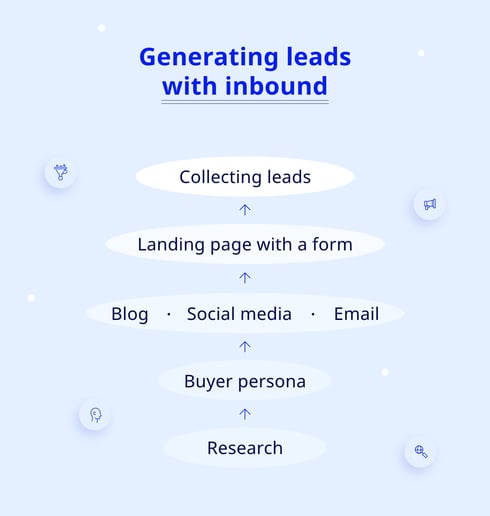
Inbound marketing helps increase site traffic
The basis for increasing website traffic is to publish relevant content to the target audience, so much so that they are willing to share it further. The content must be tailored to personas and SEO optimized.
Here is proof that this approach works. After implementing a content marketing strategy for an American client providing medical call center services, we quickly observed increasing website traffic. The growth was pronounced just a few months into regular posting. The content created by our team, tailored to well-defined personas, enjoyed so much interest that the client has now been cooperating with us for many years. Below we illustrate how the correct implementation of the inbound strategy, in this case, helped revitalize the brand and reach a whole host of new, dedicated customers:
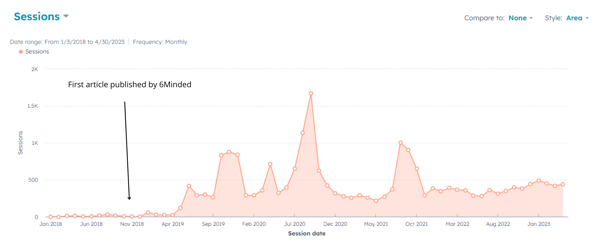
Many years of inbound marketing activities for one of our clients increased traffic on the company’s website
Inbound marketing strengthens the brand’s reputation
An inbound marketing strategy is also invaluable in building brand awareness and offering relevant, interesting, and helpful content. It will help your audience recognize your brand and bring it back to your resources over and over again for useful insights.
However, to be perceived as a friendly, helpful, and competent brand, you need a coherent message and consistent tone of voice tailored to the target customer. Still, even though inbound is a long-term strategy, it does not exclude short-term, one-off targeted activities, e.g., SEM campaigns, to amass a larger pool of leads. Like flowers in the garden, in B2B inbound marketing, we can reconcile many useful, although different, tactics and tools.
Take Docplanner Group as an example. The company creates healthcare solutions for professionals and patients around the world. It adapts its website and blog content to users' needs depending on their location. In Poland, it is known as the portal ZnanyLekarz and in Spain—as Doctoralia. Thanks to this approach, Docplanner is effectively remembered by its recipients in different countries, responding to their unique needs.
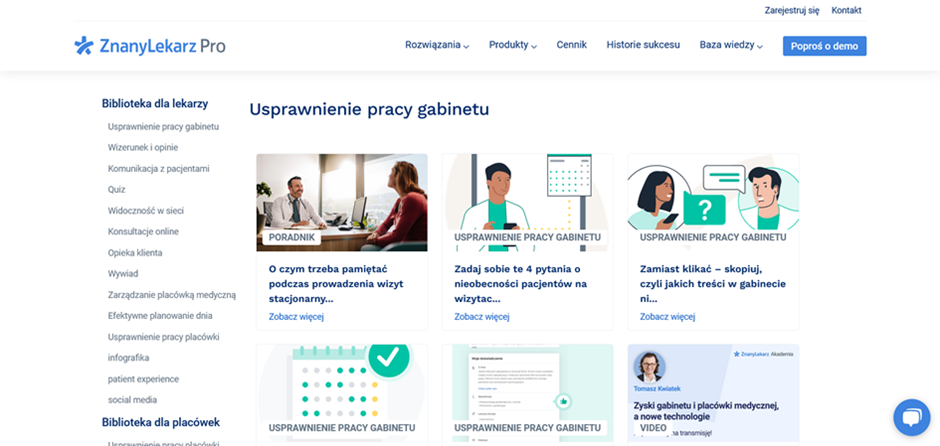
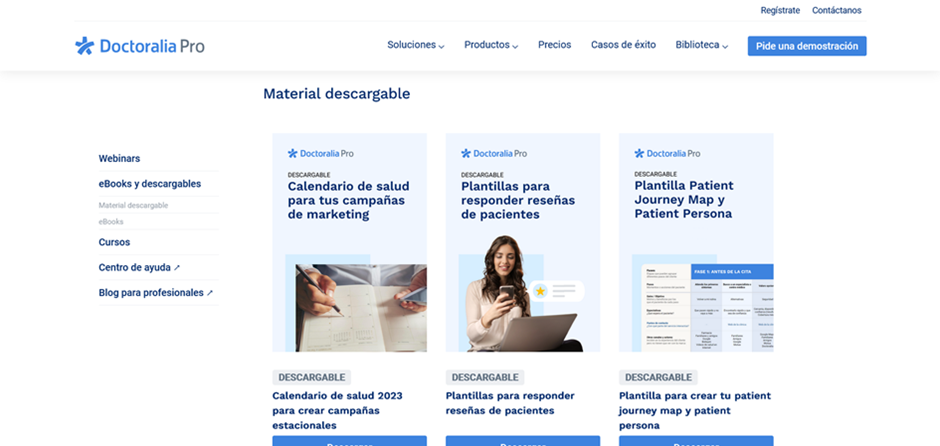
The knowledge base for specialists using Docplanner varies depending on the needs of users in different countries
Inbound marketing breeds measurable results
Inbound marketing does not exist without data. For the strategy to bring the desired effects, you must know what works and how to improve specific actions. Here, various KPIs come to the aid, which on platforms such as HubSpot are quite easy to analyze. One of the most important performance indicators for inbound campaigns include:
- Marketing Qualified Lead (MQL) — a lead that has passed the initial qualification and has great potential to become a customer.
- Conversion Rate (CR) — the percentage of visitors who perform the desired action. This may include, for example, filling out an online form, signing up for a newsletter, or making a purchase.
- Return on Investment (ROI) — the profit achieved compared to the campaign outlay.
- Organic Traffic — the number of users who visited a website after clicking on a link in the search results.
- Customer Acquisition Cost (CAC) — a measure of the costs incurred to acquire a customer.
- Lifetime Value of a Customer (LTV) — the total revenue expected to be generated by a specific customer.
An example of optimization that we use for each campaign in our inbound marketing agency is adjusting the content of landing pages based on statistics to maximize the number of requests for demos of our services.
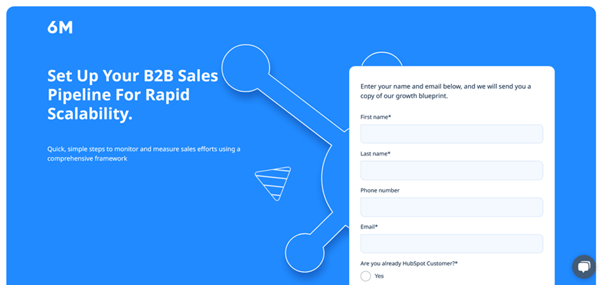
Each landing page with a form to download an eBook, guide, or other content provides a chance to get new leads
Inbound marketing lines up marketing and sales activities
The symbiosis of marketing and sales seems obvious, but unfortunately, many companies still underestimate its value. But why is the sales/marketing alignment so beneficial?
Here are some reasons. Companies where sales and marketing go hand in hand report significantly more success in closing sales (67%) and up to 209% more revenue from marketing. On the other hand, 79% of marketing leads never convert into sales because of the lack of maintaining relationships with potential customers.
The lack of a common goal, consistent processes, and uniform strategy brings chaos to operations and disrupts team dynamics. As a result, unnecessary problems arise that negatively affect the image and success of the company. On the other hand, unanimously defined customer persona and qualified leads make it possible to create engaging content, efficiently close sales, and increase profits.
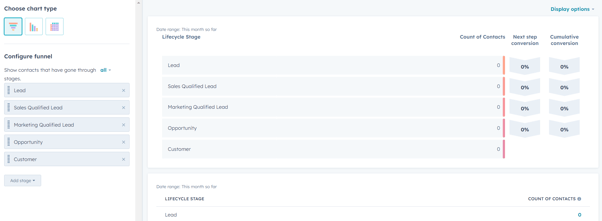
HubSpot’s inbound marketing platform provides common tools that allow sales and marketing teams to work in one place with access to the same data
An inbound marketing strategy works wonders, but it takes time
Being a long-term strategy is the biggest advantage and disadvantage of inbound marketing. If you are patient, a once-launched inbound marketing campaign will bear fruit for a long time without additional investment. But like plants in the garden, the return from inbound will not grow overnight. It happens that marketers, irritated by this fact, force premature changes in their inbound campaigns without measuring their results in the long run. They pour out the germinating plant, letting it wither away.
With data collected in the span of several months, you can reliably measure the efficiency of your inbound marketing efforts. Maybe something didn’t work as expected. This does not mean that the whole inbound strategy should go to waste. On the contrary, it is an opportunity to draw conclusions, test, and make changes that can often be as minor as replacing the CTA or promoting another article on social media.
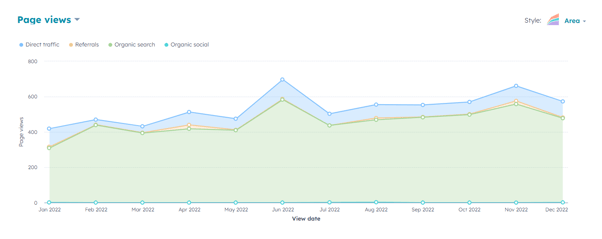
Only data collected over a longer period can tell whether a given asset has proven to be effective
When should you consider inbound marketing for your B2B?
At 6Minded, we have seen our B2B clients grow substantially by implementing inbound marketing strategies. But experience has taught us that inbound isn’t made for everyone.
In general, an inbound marketing strategy works best in the case of:
- B2B companies with a long sales cycle – During a long sales cycle, potential customers need assets that will provide them with information and guide them through the entire process. Engaging content such as articles or videos will be perfect to reach that goal.
- Fast-growing companies – Inbound marketing is focused on development, and its methods are great for attracting the attention of customers and engaging them while they are involved in decision-making regarding the purchase. Additionally, the methodology is designed to generate exponential growth in traffic in leads, your inbound campaigns will yield results even when you don’t spend time on them anymore.
- Companies focusing on automation and metrics – Inbound lets companies easily measure their strategy efficiency and make agile changes to content and investments. So instead of acting blindfolded, you get specific metrics and benchmarks and can use them as cues to improve your campaigns constantly.
- Limited budget – Inbound marketing does not require large investments to achieve the desired results. Creating articles providing valuable advice and containing relevant key phrases can efficiently generate leads even on a small budget.
- Good knowledge of the target group – If we know our customers well, we understand their needs and what to do to meet them. Inbound marketing techniques allow for constant contact with our audience and data collection that leads to even more personalized messages in future campaigns.
Get the most out of inbound marketing strategy
We hope that by now, you understand the benefits of inbound marketing strategy a tiny wee better. And that you won’t dismiss it anymore as a futile effort but instead see it as a fruitful strategy that needs some time to ripen. And regardless if you have green fingers or not, we encourage you to experiment with the inbound methodology.
💚 Just remember about us if you need a hand in cultivating your growth through inbound. Good harvest!

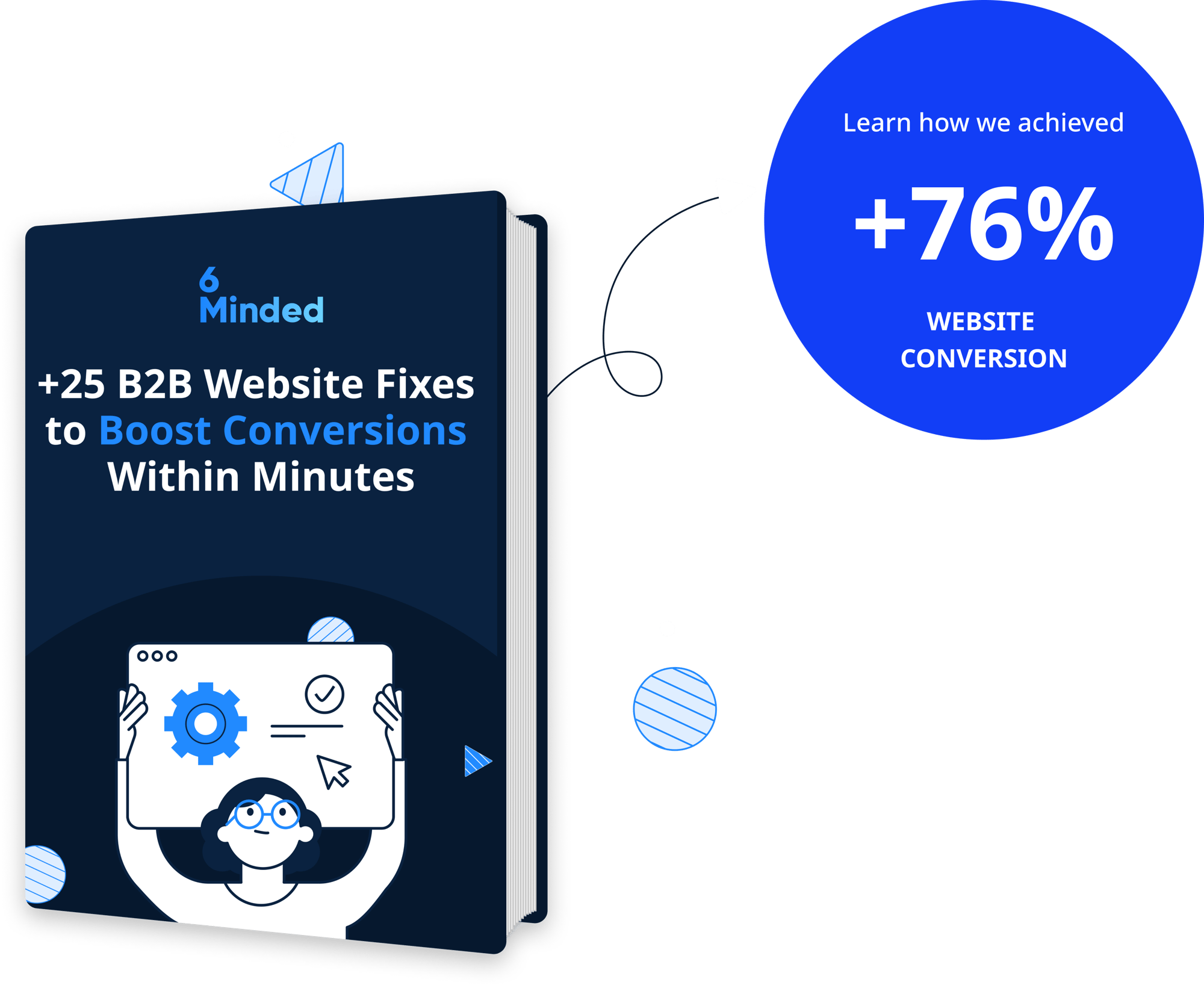
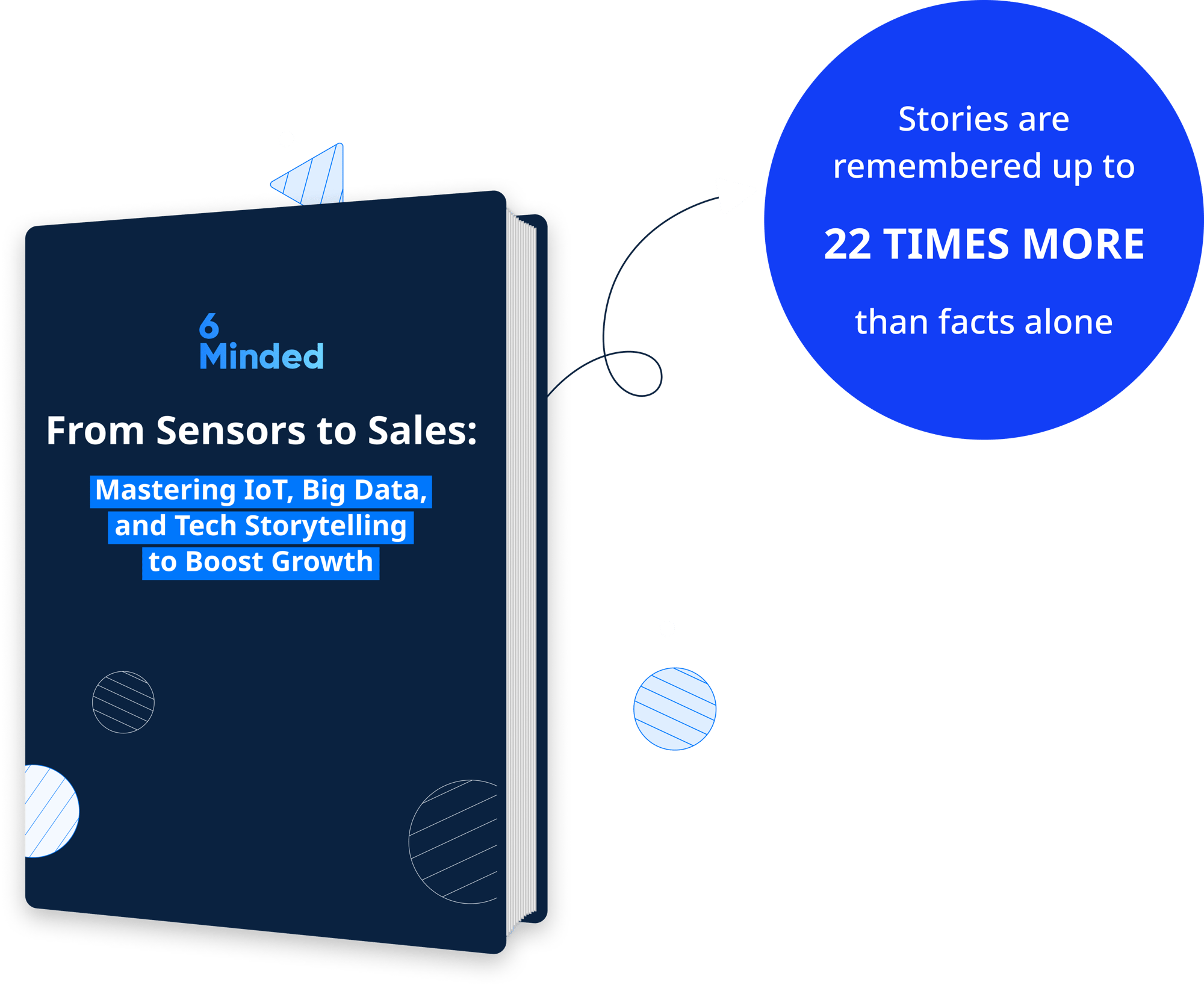
 September 2023
September 2023
